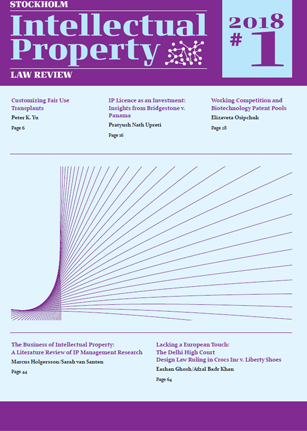
STOCKHOLM INTELLECTUAL PROPERTY LAW REVIEW
Åsa Hellstadius & Frantzeska Papadopoulou
Editorial
While writing these few words and preparing to send the next issue of Stockholm IP Law Review to the print, the world as we know it is not the same. It has been some five months since the first news of the COVID-19 outbreak reached us, and since then the worldwide expansion of the pandemic has gradually but steadily influenced the way we live, the way we work and the way we socialize. It has been a time of cancellations of conferences and meetings, an equally long time since we entered an airplane or travelled anywhere to begin with. Teaching, meetings and seminars have moved from “in real life” to digital platforms, and we have had to familiarize ourselves with communication tools such as Zoom, Teams, Skype etc., experiencing both pros and cons from this transition. It does not come as a surprise that the IP world was to be influenced as well. By mid-March both the EUIPO and the EPO announced that they would extend the deadlines directed to parties until the beginning of May. Shortly afterwards the same was announced for the Community Plant Variety Office. Starting end of March, IP Courts in the UK moved the proceedings from the analogue world to digital meetings. Reading the guidelines published by the Courts, leaves no doubt about the practical challenges of this change of environment. Apart from the pure technical issues concerning IP practice, governments have taken steps in order to address the COVID-19 crisis by making use of exceptions to IP rights. The Israeli Government, acting through its Minister of Health with the authorization of the Attorney General of Israel, issued a precedential permit for the use of three Israeli patents covering the anti retrovirus drug “KALETRA” in order to import quantities of a generic version of the drug for use in the treatment of patients suffering from the COVID-19 virus. Several other countries, such as India, Mexico and Italy to name a few have explored the possibilities to make use of compulsory licensing in order to guarantee access to pharmaceuticals and to necessary equipment to deal with the pandemic. In this process, the role of patent rights, orphan drugs designations and even trademarks have been presented and debated in IP blogs and in webinars. The work of our journal has also been influenced. Several of the members of our editing team had to fly back to their home countries, and we have postponed our yearly seminar from May to December 2020. Despite this, we are pleased that the Stockholm IP Law Review spring issue of 2020 has come together, even though we in the editorial team had to practice social distancing during the work. Looking back to one year ago, it is of interest to note that several of the articles of the 2019 spring issue , as well as our conference on the 4th of June 2019 concerned public health issues. Reading the articles now, during the COVID-19 pandemic, their relevance and importance is renewed. This 2020 Spring issue of Stockholm IP Law Review does not focus on COVID-19 issues, but on other important and timely issues, the IP challenges of the digital world. In the article by Holgersson, Granstrand and Opedal we find out what an innovation ecosystem is and how multilayered licensing influences fairness considerations in capturing and sharing value within contributors. Rosati’s article on the other hand, analyzes the approach adopted by the CJEU regarding direct liability of online intermediaries in relation to user activities. Hyperlinking on the internet, and how this is classified from a copyright perspective is discussed by Bohle in her article, that includes the most important case law of the CJEU concerning the interpretation of Article 3(1) of the Infosoc Directive. The business opportunities and the legal loopholes of blockchain solutions for the online music industry are discussed by Carretta, while Kempas reflects on IP considerations on AI in Europe and in Sweden.
We hope you enjoy the reading and that the next issue of our journal comes at a time when we may deliver the issues in person.
Åsa Hellstadius & Frantzeska Papadopoulou
Towards fair pricing in technology trade and licensing
By Ove Granstrand, Marcus Holgersson & Andreas Opedal
ABSTRACT
In today’s complex and digital business landscape, innovation is typically not an effort of a lonely genius or an activity confined to a single corporate R&D lab. Instead, the innovation process often involves open innovation, technology trade, and intellectual property (IP) licensing between multiple firms in what is sometimes referred to as an innovation ecosystem. While this interaction is conducive to value creation, it also creates a pressing need for better methods and principles for fairly capturing and sharing value among contributors. The purpose of this paper is to shed light on the plurality and specificity of fairness principles, how they appear in IP negotiation experiments with 105 participants, and what outcomes they generate compared to competitive behavior. The paper especially highlights how investments and the structure of innovation actors, artifacts (such as patents), and activities impact fairness.
The Direct Liability of Online Intermediaries for IPR Infringements
By Eleonora Rosati
ABSTRACT
One of the most interesting and relevant developments in respect of online intermediaries concerns the emerging possibility – especially in the copyright field – to go beyond the traditional approach to their liability based on the safe harbour legislation and, with that, the system of secondary/accessory legislation and root, instead, their liability within a primary/direct liability regime, also in relation to user activities and user-uploaded content. This contribution explains how the Court of Justice of the European Union has come to consider the possibility of direct liability of online intermediaries in relation to user activities and undertakes a reflection on the implications of said approach, also with regard to its application to less egregious scenarios than piracy-focused platforms and other IP rights (notably: trade marks).
Copyright in the digital age
By Sophie-Elena Bohle
ABSTRACT
This article evaluates the interpretation of the right of communication to the public, as per Art. 3(1) of Directive 2001/29/EC (the InfoSoc Directive), within the context of hyperlinking on the internet undertaken by the Court of Justice of the European Union (CJEU) in its case law over the last years on EU level as well as by the Federal Court of Justice in Germany (BGH). In order to determine how the interpretation – in particular the development of the new public criterion by the CJEU – influences the interests of authors and users, and the functioning of the internet, an in-depth analysis of the case law of the CJEU and the BGH is conducted. Thereby, the conditions under which the setting of a hyperlink infringes the right of communication under Art. 3(1) of the InfoSoc Directive are outlined. In this framework, the influence of the CJEU on the jurisprudence of the BGH is discussed. Ultimately, this article assesses the extent to which CJEU case law has given rise to alternative proposals regarding the treatment of hyperlinks, discussing both challenges and endorsements.
Blockchain solutions for the online music industry
By Silvia A. Carretta
ABSTRACT
New technological developments are changing the legal status of copyright. As blockchain technology seems to be revolutionising modern times, it is difficult to underestimate the hype around this technology. This article introduces various legal aspects of the application of blockchain technology in the copyright sphere, with specific reference to the analysis of the online music industry in its modern status. Within this framework, it could be assumed that blockchain technology might represent an opportunity to reimagine and revamp the protection of copyright by implementing a blockchain-enabled system with the characteristics of being trustworthy, transparent, more affordable, highly standardised, time-stamped and automated. Although still in its infancy, the potential application of this technology in relation to the music industry is of particular interest, as it appears to offer solutions to problems that artists, musicians, performing artists, and composers have encountered for decades. It promises a way out of the current deadlock between artists and intermediaries and it offers a foundation that can bring together the entire value chain and revamp the music industry by letting go of the outdated, hierarchic framework. The complexity of the current system will take some time to unravel and rebuild. Nevertheless blockchain applications could lead to better protection of ownership, to artists having more say in deciding how and to whom the works are licensed and to faster, prompter remuneration of holders in the music industry, allowing artists to make a living out of creating music.
A note on artificial intelligence
and intellectual property in Sweden and the EU
By Tobias Kempas
ABSTRACT
Artificial intelligence (“AI”) is a key driver of the fourth industrial revolution. AI systems and machine learning technologies are already having a significant impact on the development, production and sales of a vast range of economic and cultural goods and services.
Inevitably, seeing that AI blurs the boundaries between the physical, digital, and biological worlds, AI intersects with the Swedish and European intellectual property (“IP”) framework at several different points. In fact, the technological evolution brings into question a number of fundamental IP concepts relating to, e.g. IP protection of creative or innovative results generated by intelligent software. In addition, seeing that AI technologies are already affecting many business sectors and are likely to become even more essential to modern life in the future, the IP protection of AI technologies as such will be important to incentivize continued technological research and development. Given how fast AI is evolving, more legal and economic research is needed to ensure that IP law will continue to encourage new technologies, artistic expressions and inventions. Policymakers should discuss and determine whether the current state of IP law, including the humanistic approach to IP protection, meets tomorrow’s needs. Arguably, contemporary IP law may have to be changed or at least supplemented by new rules and principles, to ensure that the law will serve its purpose and remain relevant in the new AI era.
